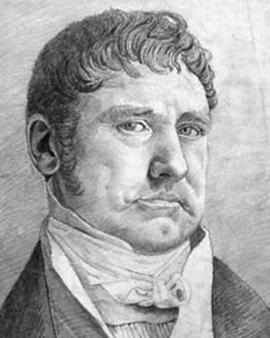


A virtuoso artist and inventor, a visionary who excelled in science and the arts alike - these are just some of the titles Cornelius Varley (1781-1873) earned in the world of art and science. His contributions to society are of unparalleled importance, including the invention of the graphic telescope and microscope. Varley, born in Hackney, then a village north of London, found his artistic inspiration and scientific talent in the bosom of his own family. One of his brothers, John Varley, an accomplished watercolorist and astrologer, introduced him to the world of art. Traveling together through Wales sparked Cornelius Varley's love of painting. Under the tutelage of his uncle, a maker of scientific instruments, he developed a passion for natural science. Over the years, Cornelius has masterfully utilized his expertise in both art and science, making immeasurable contributions in both fields.
Cornelius Varley's oeuvre is a symphony of classical themes, infused with architectural elements and richly detailed figures. His etchings of boats and other watercraft on the Thames remain unforgotten to this day. Varley's masterpieces, however, are more than just artistic creations. His inventions, including improvements to the camera lucida and camera obscura long used by artists, enabled him to sketch both landscapes and microscopic studies with impressive clarity. Varley's tireless ambition and drive for innovation made him an outstanding inventor of his time. His achievements won multiple awards, including silver medals from the Society of Arts and the prestigious Isis Gold Medal for improvements to microscopes. The graphic telescope, a groundbreaking invention Varley created in 1809 and patented in 1811, is a testament to his inventive mind. After being unable to find a manufacturer willing to produce it, he took manufacturing into his own hands. This determination was rewarded at the Great Exhibition of 1851, where he received a medal for his graphic telescope.
In our quest to honor Varley's immeasurable contributions to art and science, we offer fine art prints of his impressive works. Each print is reproduced with the utmost care and dedication to preserve the delicacy and precision of Varley's original works. From his carefully crafted classical subjects to his stunning depictions of boats on the Thames, these fine art prints are windows into a bygone era when art and science went hand in hand. Experience the fascination of Cornelius Varley's genius through our exclusive art prints. Depicting both the splendor of nature and the advancement of technology, his works are more than just paintings - they are contemporary witnesses to the immense beauty and relentless pursuit of knowledge. With our art prints, we bring Cornelius Varley's incomparable art and inventions into your home.

A virtuoso artist and inventor, a visionary who excelled in science and the arts alike - these are just some of the titles Cornelius Varley (1781-1873) earned in the world of art and science. His contributions to society are of unparalleled importance, including the invention of the graphic telescope and microscope. Varley, born in Hackney, then a village north of London, found his artistic inspiration and scientific talent in the bosom of his own family. One of his brothers, John Varley, an accomplished watercolorist and astrologer, introduced him to the world of art. Traveling together through Wales sparked Cornelius Varley's love of painting. Under the tutelage of his uncle, a maker of scientific instruments, he developed a passion for natural science. Over the years, Cornelius has masterfully utilized his expertise in both art and science, making immeasurable contributions in both fields.
Cornelius Varley's oeuvre is a symphony of classical themes, infused with architectural elements and richly detailed figures. His etchings of boats and other watercraft on the Thames remain unforgotten to this day. Varley's masterpieces, however, are more than just artistic creations. His inventions, including improvements to the camera lucida and camera obscura long used by artists, enabled him to sketch both landscapes and microscopic studies with impressive clarity. Varley's tireless ambition and drive for innovation made him an outstanding inventor of his time. His achievements won multiple awards, including silver medals from the Society of Arts and the prestigious Isis Gold Medal for improvements to microscopes. The graphic telescope, a groundbreaking invention Varley created in 1809 and patented in 1811, is a testament to his inventive mind. After being unable to find a manufacturer willing to produce it, he took manufacturing into his own hands. This determination was rewarded at the Great Exhibition of 1851, where he received a medal for his graphic telescope.
In our quest to honor Varley's immeasurable contributions to art and science, we offer fine art prints of his impressive works. Each print is reproduced with the utmost care and dedication to preserve the delicacy and precision of Varley's original works. From his carefully crafted classical subjects to his stunning depictions of boats on the Thames, these fine art prints are windows into a bygone era when art and science went hand in hand. Experience the fascination of Cornelius Varley's genius through our exclusive art prints. Depicting both the splendor of nature and the advancement of technology, his works are more than just paintings - they are contemporary witnesses to the immense beauty and relentless pursuit of knowledge. With our art prints, we bring Cornelius Varley's incomparable art and inventions into your home.
Page 1 / 1






